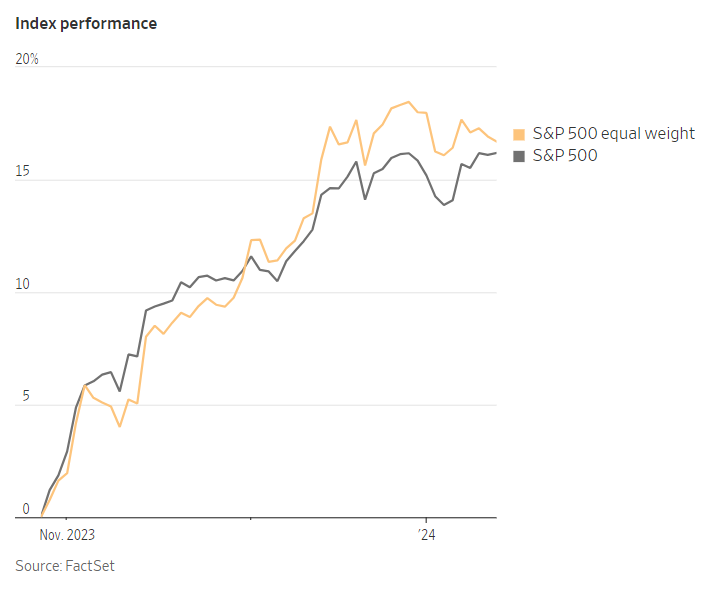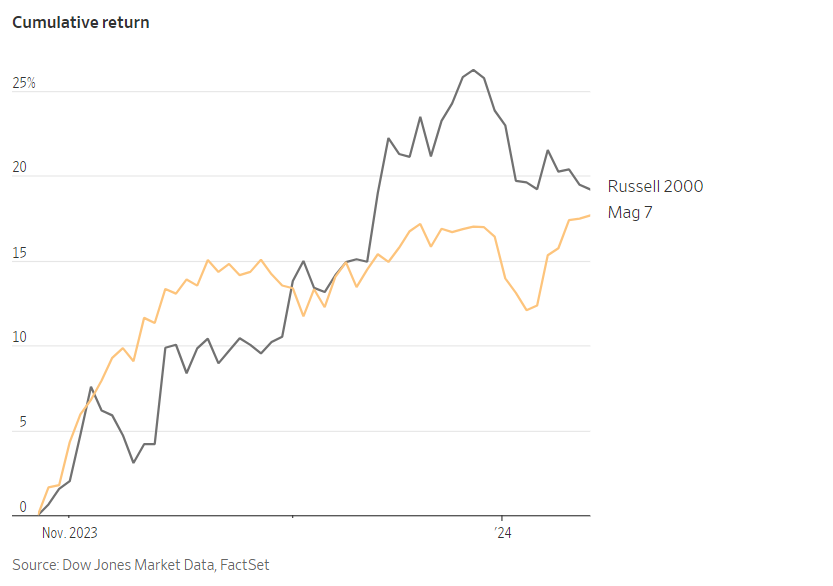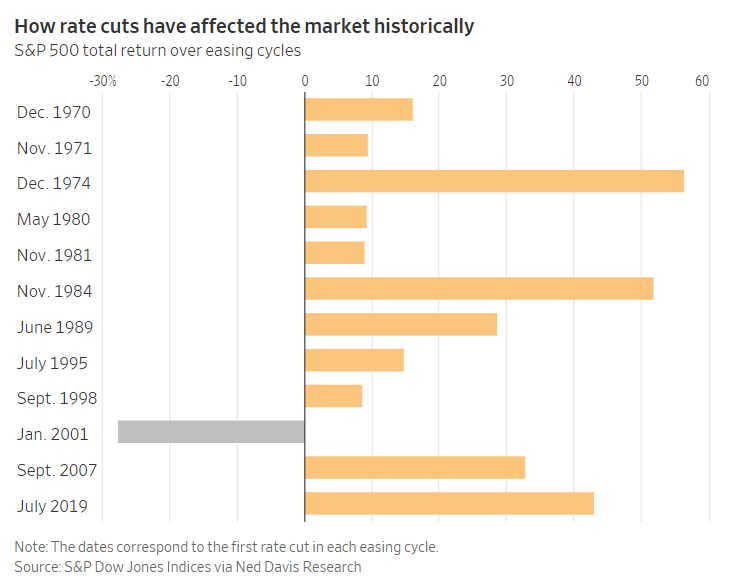
By Hardika Singh
Jan. 16, 2024
The blockbuster stock market rally stalled once the calendar flipped to 2024.

iStock image
Some of the big tech stocks that drove the market’s advance last year appear to have run out of gas, government-bond yields have risen and inflation might not be cooling as quickly as some investors had hoped. After a rocky start to the month, the S&P is clinging to a 0.3% advance in January.

Investors say a decline in enthusiasm is normal after a stretch of robust gains like those that capped 2023. They also say they have many questions about the path of the economy and interest rates that will be key to discerning the market’s trajectory this year.
These are some of the biggest ones:
Can the stock rally broaden beyond the Magnificent Seven?
Stocks jumped out of the gate last year to the surprise of almost everyone. The problem? Just seven big tech stocks—Apple, Microsoft, Alphabet, Amazon.com, Nvidia, Tesla and Meta Platforms—were responsible for most of the S&P 500’s gains. That sparked worries about the health of the rally and whether the market would be vulnerable to a downturn if a few of the heavyweights faltered.

This year, many investors expect a revival in shares in beaten-down areas of the market, a bullish sign among strategists who view expanding market breadth as a signal that a rally has legs.
Investors have reason to be hopeful. Since the stock market’s recent low on Oct. 27, the small-cap-focused Russell 2000 has gained 19% and the equal-weighted S&P 500, which gives the same status to the smallest and largest companies in the index, has added 17%. Both indexes have outpaced the traditional S&P 500’s 16% advance.
The S&P 500 sectors off to the strongest start in January are healthcare, communication services and consumer staples, all up at least 1.2%.
Can we expect stocks to keep climbing once the Fed cuts interest rates?
Stocks got off to a bumpy start in January after ending 2023 with a bang. That prompted questions about whether markets had run too far too fast and if the Fed’s expected rate cuts were already priced in.
Stocks typically struggle to establish a strong footing ahead of the first rate cut in an easing cycle. Since the 1970s, the S&P 500 has noted a median decline of 1.8% in the three months leading up to the first rate cut, according to Ned Davis Research. The picture improves after that, with stocks gaining an average of about 20% over the course of an easing cycle, NDR said.

“Seems like what we did in December is priced in an awfully good outcome for a soft landing,” said Joe Kalish, chief global macro strategist at NDR. “Not saying it’s not possible, but it could be difficult to pull that off and keep the unemployment rate from rising and have inflation come down.”
Wait, is a recession still in the cards?
Many economists have lowered their estimates on the probability of a recession. That is mostly thanks to a decline in inflation, strength in the labor market, cooling wage growth and strong consumer spending.
But Fed policymakers expect the economy to grow at a slower rate this year compared with last and for the jobless rate to rise to 4.1% by the fourth quarter. As their pandemic-era savings are depleted, consumers could pull back on spending as well.

Typically, the effects from monetary-policy tightening take time to filter through the economy. Since the late 1950s, an average of 23 months have passed between the initial rate increase of a hiking cycle to the beginning of an economic downturn, according to Jeff Schulze, head of economic and market strategy at ClearBridge Investments. This hiking cycle started 21 months ago.
“Gosh, we got ahead of ourselves in thinking that because it was the fastest and highest rate-hiking cycle in our recent history, it would lead to the fastest and deepest recession,” said Jeff Klingelhofer, co-head of investments at Thornburg Investment Management. “That didn’t happen. But just because it didn’t happen doesn’t mean we’re not on target for still a pullback.”
Will this be a good year to buy a home?
The 30-year fixed mortgage rate peaked near 8% last fall, putting homeownership out of reach for many Americans. It has since fallen to 6.66%, according to mortgage giant Freddie Mac, and should keep dropping if the Fed sticks to its forecasts.
In December, the central bank penciled in three interest-rate cuts this year, and traders in the derivatives market are betting that rates fall even more. That would offer a respite to would-be home buyers who have been sidelined by high borrowing costs and allow those locked in at higher rates to refinance.
Write to Hardika Singh at hardika.singh@wsj.com
Dow Jones & Company, Inc.



